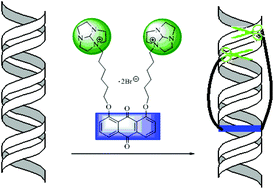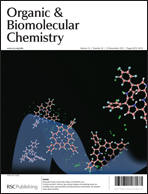Synthesis and enhanced DNA cleavage activities of bis-tacnorthoamide derivatives†
Abstract
A new metal-free DNA cleaving reagent, bis-tacnorthoamide derivative 1 with two tacnorthoamide (tacnoa) units linked by a spacer containing anthraquinone, has been synthesized from triazatricyclo[5.2.1.04,10]decane and characterized by NMR and mass spectrometry. For comparison, the corresponding compounds mono-tacnorthoamide derivative 2 with one tacnorthoamide unit and 6 with two tacnorthoamide units linked by an alkyl (1,6-hexamethylene) spacer without anthraquinone have also been synthesized. The DNA-binding property investigated via fluorescence and CD spectroscopy suggests that compounds 1 and 2 have an intercalating DNA binding mode, and the apparent binding constants of 1, 2 and 6 are 1.3 × 107 M−1, 0.8 × 107 M−1 and 8 × 105 M−1, respectively. Agarose gel electrophoresis was used to assess plasmid pUC19 DNA cleavage activity promoted by 1, 2, 6 and parent tacnoa under physiological conditions, which gives rate constants kobs of 0.2126 ± 0.0055 h−1, 0.0620 ± 0.0024 h−1, 0.040 ± 0.0007 h−1 and 0.0043 ± 0.0002 h−1, respectively. The 50-fold and 15-fold rate acceleration over parent tacnoa is because of the anthraquinone moiety of compound 1 or 2 intercalating into DNA base pairs via a stacking interaction. Moreover, DNA cleavage reactions promoted by compound 1 give 5.3-fold rate acceleration over compound 6, which further demonstrates that the introduction of anthraquinone results in a large enhancement of DNA cleavage activity. In particular, DNA cleavage activity promoted by 1 bearing two tacnoa units is 3.3 times more effective than 2 bearing one tacnoa unit and the DNA cleavage by compound 1 was achieved effectively at a relatively low concentration (0.03 mM). This dramatic rate acceleration suggests the cooperative catalysis of the two positively charged tacnoa units in compound 1. The radical scavenger inhibition study and ESI-MS analysis of bis(2,4-dinitrophenyl) phosphate (BDNPP) and adenylyl(3′-5′)phosphoadenine (APA) cleavage in the presence of compound 1 suggest the cleavage mechanism would be via a hydrolysis pathway by cleaving the phosphodiester bond of DNA.


 Please wait while we load your content...
Please wait while we load your content...